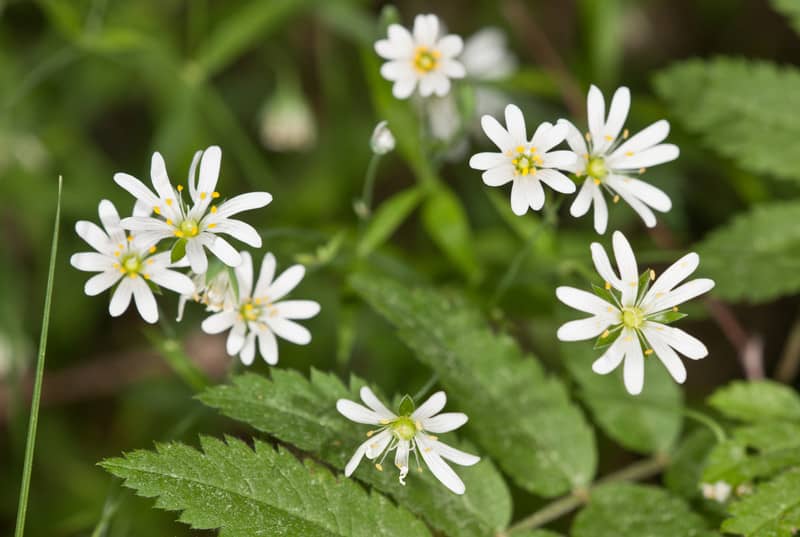Chickweed is an annual plant that competes vigorously with other plants. It is edible.
Botanical name: Stellaria media
Organic Weed Control at Amazon
- Monterey Vegetable Pre-Emergent Weed Control
- Homietina Heavy Duty Weed Barrier Fabric 4×300-feet
- Preen Natural Vegetable Garden Weed Preventer
- Green Gobbler 20% Vinegar Weed and Grass Killer
- WeedGuard Plus Biodegradable Paper Weed Barrier

Chickweed description and life cycle
- Bright green, mat forming low grower with multiple branches from a central crown.
- Stems 1½ to 3 feet long.
- Leaves are oval and pointed at the tip, smooth and shiny, opposite in pairs on the stem.
- White 1½ inch flowers with 5 split petals that look like 10 petals; blooms in spring.
- Red-brown seeds with bumpy ridges; sets seed in fall.
- Reproduces by seed and creeping and rooting stems.
- Prefers rich soil; tolerates acid soil.
- Chickweed ground cover will slow soil erosion.
Chickweed root system
Chickweed has a fibrous, shallow root system. Weeded debris including stem parts or roots left in the garden will re-root and generate new plants.
Chickweed organic control
- Hand weed; pull up root and all; best done early in the season.
- Remove all roots and plant parts from the garden; even small roots left behind can re-root.
- Mulch with a layer of cardboard or newspaper with bark chips on top to kill plants.
- Do not allow to spread and cover ground; competes vigorously with other plants.
- Solarization using clear plastic mulch will heat the soil and kill seeds but also may kill beneficial soil microorganisms.
Chickweed range
Throughout the United States and southern Canada.
Four quick ways to control weeds
- Weed early. Control weeds in the first month after they germinate.
- Weed often. Hand weed every two weeks through the season.
- Weed by hand when the soil is wet (best to get roots).
- Use a hoe if the soil is dry. Decapitate weeds before they flower and drop seed.
Related articles:
Vegetable Garden Organic Weed Control
Vegetable Garden Organic Pest Control
Vegetable Garden Diseases Problem Solver
Garden Planning Books at Amazon:
- Vegetable Garden Almanac & Planner
- Kitchen Garden Grower’s Guide Vegetable Encyclopedia
- Vegetable Garden Grower’s Guide
- Tomato Grower’s Answer Book















